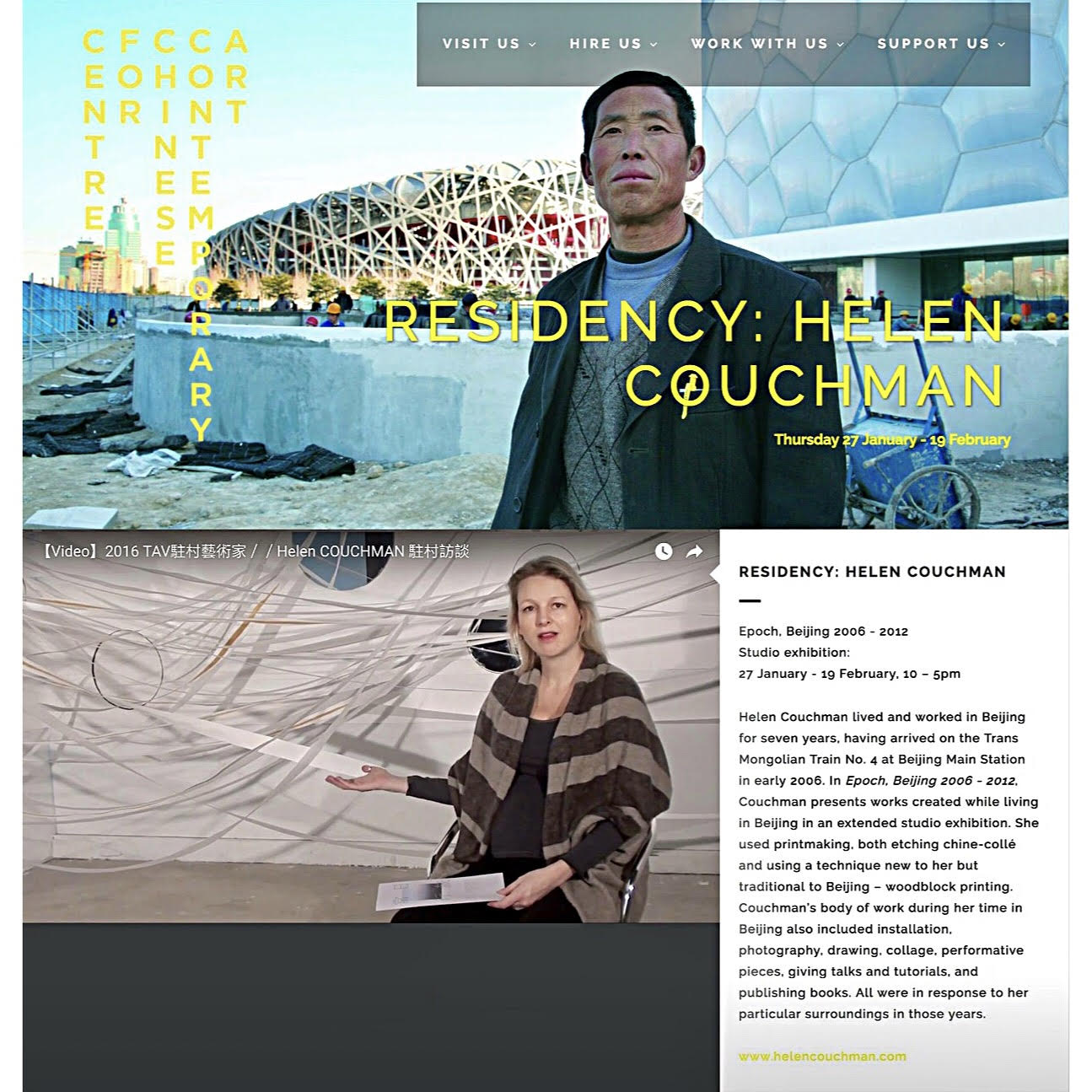Epoch, Beijing 2006 – 2012 at the Centre for Chinese Contemporary Art
Epoch, Beijing 2006 – 2012
新时代,北京 2006年至2012年
Works by Helen Couchman, Beijing 2006 – 2012
CFCCA, Centre for Chinese Contemporary Art, Manchester, UK.
27th January – 19th February 2017
(Installation shots of the exhibition can be seen here.)
Helen Couchman lived and worked in Beijing for nearly seven years, having arrived on the Trans-Mongolian Train No. 4 at Beijing Main Station in early 2006 and then leaving for a project in New York City at the end of 2012. In that period, she created a number of works. Some involved printmaking, both etching chine-collé and using a technique traditional to Beijing – woodblock printing. Couchman’s body of work during her time in Beijing also included installation, photography, drawing, collage, performative pieces, giving talks and tutorials, and publishing books. All were in response to her particular surroundings in those years.
Those years. Ask any historian to define a period or an era. They argue endlessly about when one era ends, and another begins and over just what defines an age. How to identify the beginning of an era? What constitutes an epoch’s end?
The question becomes even harder when considering the history of China and where China is today. Did Couchman witness the ‘Post-Mao Era’? The ‘Post-Tiananmen Age’? It was a time of Olympic fever. Was the Beijing of “One World, One Dream” already beginning to fade as Couchman departed in 2012, only to be replaced by the more nationalistic concerns of a new leader for a new era: Xi Jinping and his specifically “China Dream?”
Looking back at the time between 2004-2013 from the perspective of the present, Couchman feels nostalgia for a moment come and gone. Beijing (or at least the nearby city of Zhangjiakou) is getting ready for the Winter Games of 2022. But compared to the excitement and anticipation which gripped the city and its people in the run up to the 2008 Summer Games, the atmosphere feels muted, the excitement less palpable.
In 2008, China reached out to the world and Beijing was radically re-sculpted. The song, “Beijing Welcomes You,” was played almost non-stop that year as the city was made orderly for the games, but some asked who might be excluded from that welcome. An unintentionally prescient question it turns out, as the period Couchman worked in Beijing did constitute a particular era, one that in 2016 many look back upon with the same nostalgia as Couchman.
The air is better in China in 2016 than it was a decade ago and new Internet applications make life for urbanites easier. The country is in a much stronger position internationally both in economic and strategic terms. No doubt these are successes.
But there are growing restrictions on expression with new pressures on scholars, artists, and non-governmental organizations. The domestic Internet offers a range of conveniences at high speed, but access to the outside world shrinks year on year. Galleries close. Film festivals cancel. Critiques of the state and society are dismissed as being influenced by nefarious foreign forces. It is as chilly an intellectual and artistic climate as at any time in the past three decades.
Couchman’s chose to work in Beijing, responding to Beijing in a particular period. These pieces represent a window not just into a recent past in Beijing and China, but also to an alternate vision of a future. One that embraces the kind of international cosmopolitanism celebrated in Beijing in 2008 and then again a year later with the Shanghai World Expo. The values of the Olympics, the opening of hearts and minds to friends from abroad, made this a special time for all living in Beijing.
We are all products of our culture, but we are also products of a shared humanity. It is what connects art, subject, and viewer. It is what gives us common cause to embrace visitors to our home or to reach out across the world to make new friends. It was in this spirit that Couchman made these works, images of what turned out to be a very special era in Beijing.

CFCCA website: Above, WORKERS, below, interview filmed at TAV, Tiapei, Taiwan
新时代,北京 2006年至2012年
Epoch, Beijing 2006 – 2012
Helen Couchman的作品,2006年至2012年,于北京
CFCCA, Centre for Chinese Contemporary Art
2006年初Helen Couchman乘坐着横穿蒙古的第4号列车抵达了北京火车总站,便在北京生活并工作了七年,此后于2012年底离开,前往纽约的一个项目。在北京的那段时间里,她创作了许多作品。她运用了版画技巧,既有蚀刻版画,又有雕版印刷(即北京的传统技巧,但对她来说却是一门新技术)。Couchman在北京期间的工作还包括装置艺术、摄影、绘画、抽象拼贴画、表演艺术作品、讲座及教学,还发表了一些书籍。所有这些都来自于她在那些年里对周围特殊环境和事物所作出的反应。
那些年。让任何一个历史学家来给一个时期或一个时代下定义。他们会就一个时代何时起止或仅仅是就由什么来定义一个时代而争论不休。如何去辨认一个时代的起始呢?是什么标志了一个时代的终止?
当考虑到中国历史和今日中国所处的位置时,这个问题就变得更加复杂了。Couchman是不是见证到了“后毛泽东时代”?“后天安门时代”?那个时候正是奥林匹克运动热的时期。北京的“同一个世界、同一个梦想”是否在Couchman2012年离开时就已经开始逐渐消失?取而代之的是一位新领袖所带来的一个更重视民族主义的新时代:习近平和他所提出的“中国梦”?
从现在的角度回顾2004年至2013年那段时期,Couchman的怀旧之情时起时伏。北京(或者说,至少是旁边的张家口市)正在为2022年的冬季运动会着手准备。然而,与2008年夏季运动会开始之前遍布整个城市和人们心中的兴奋与期待之情相比,现在这个气氛逊色了许多,兴奋之情也更不易察觉了。
2008年中国把手伸向世界,北京也被彻底地重塑了。这个城市在那年为了奥运会而变得整齐有序时,那首《北京欢迎您》的歌曲也被没完没了地播放着,但有些人问道,谁会被排除在了这个欢迎之外。一个无意间地提问却是有先见之明的,因为Couchman在北京工作的这段时间里确实包含了一段特殊的时期,这段时期让许多人在2016年时回想起来,都会产生与Couchman同样的怀旧之情。
2016年中国的空气与十年前相比要好一些,而且新因特网应用程序也让都市人的生活更加容易。从经济及战略角度来看,这个国家在国际上处在了更为强大的地位。毫无疑问地,这些都是成就。
但也出现了越来越多对表达的限制,对学者、艺术家及非政府机构施加的新压力。国内互联网以很快地速度提供了一系列便利条件,但通向外部世界的入口却逐年缩小。美术馆关闭。电影艺术节取消。对国家和社会的批评被认为是受到外部邪恶势力的影响而不予理会。知识与艺术氛围就跟过去三十年中的任何时候一样寒冷。
Couchman选择了去北京工作,以响应北京的这一段特殊时期。这些作品代表了一扇窗,不仅仅是通向北京和中国不远的过去,而且是对另一种未来的憧憬。一种欣然接受2008年在北京所欢庆的那种国际性世界主义的未来,这一点也在后来的上海世博会体现出来。奥林匹克运动会的价值观,即对海外友人们敞开心扉,给所有生活在北京的人带来了一段特别的时期。
我们都是各自文化的产物,但我们也是同一个人类的产物。这就是连系着艺术、主题与观众的东西。就是这个给予我们同一个理由将访客迎入家门,或是我们走遍世界、四海交友。就是在这样一种精神下,Couchman创作了这些作品和图像,其所描绘的也是北京一段非常特别的时期。

Poster on the UCCA, Ullens Centre for Contemporary Art, Beijing website. The image used is ‘Self portrait with Long Life Earrings’ by Helen Couchman for the artist’s talk, ‘China Stories – Collecting and Dropping, China.’ 2011.